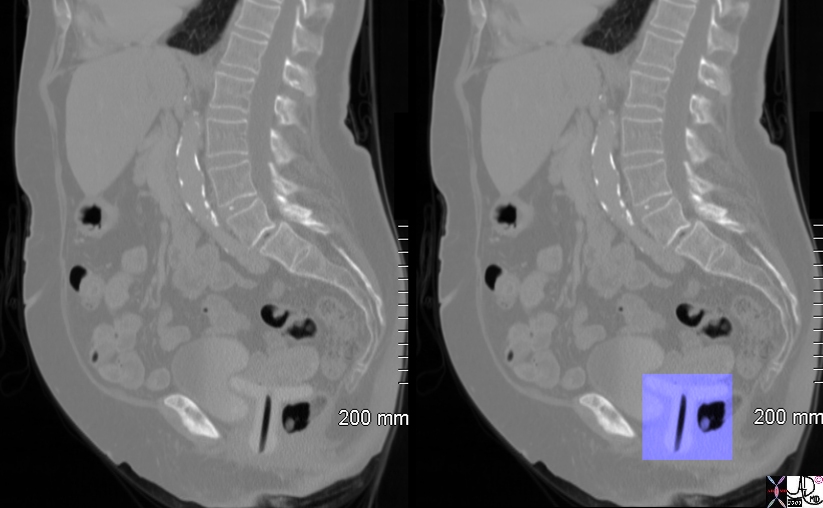Laura Miller MD
The Common Vein Copyright 2010
Definition
Uterine prolapse is a protrusion of the uterus into the vaginal lumen caused by weakening of the uterine ligaments and the support structures of the pelvic floor. This weakening is usually due to postmenopausal changes. After menopause, without the influence of estrogen, there is atrophy of the pelvic floor muscles. Uterine prolapse can also be due to trauma during childbirth. The result is gradual descent of the uterus into the vaginal lumen. The structural changes vary from slight protrusion of the uterus into the vaginal lumen to protrusion of the uterus out of the vaginal opening. The functional changes may be minimal, but can include pelvic pressure that worsens with prolonged standing or difficulty during intercourse with a large degree of prolapse. Women may be asymptomatic, but typically present clinically with pelvic pressure, dyspareunia, or a vaginal mass. Diagnosis is made based on history and physical exam including speculum examination. Treatment in some cases may be limited to hormone therapy and pelvic floor muscle exercises. A pessary may be used to mechanically support the uterus. In cases with a large degree of prolapse, surgical correction may be necessary with hysterectomy.

Vaginal Pessary to Support Pelvic Structures |
|
80 year old female with a pessary in the vagina. It is overlaid in blue and is seen as a “T shaped structure.
Courtesy Ashley DAvidoff copyright 2009 all rights reserved 83844c.8s
|
DOMElement Object
(
[schemaTypeInfo] =>
[tagName] => table
[firstElementChild] => (object value omitted)
[lastElementChild] => (object value omitted)
[childElementCount] => 1
[previousElementSibling] => (object value omitted)
[nextElementSibling] =>
[nodeName] => table
[nodeValue] =>
Vaginal Pessary to Support Pelvic Structures
80 year old female with a pessary in the vagina. It is overlaid in blue and is seen as a “T shaped structure.
Courtesy Ashley DAvidoff copyright 2009 all rights reserved 83844c.8s
[nodeType] => 1
[parentNode] => (object value omitted)
[childNodes] => (object value omitted)
[firstChild] => (object value omitted)
[lastChild] => (object value omitted)
[previousSibling] => (object value omitted)
[nextSibling] => (object value omitted)
[attributes] => (object value omitted)
[ownerDocument] => (object value omitted)
[namespaceURI] =>
[prefix] =>
[localName] => table
[baseURI] =>
[textContent] =>
Vaginal Pessary to Support Pelvic Structures
80 year old female with a pessary in the vagina. It is overlaid in blue and is seen as a “T shaped structure.
Courtesy Ashley DAvidoff copyright 2009 all rights reserved 83844c.8s
)
DOMElement Object
(
[schemaTypeInfo] =>
[tagName] => td
[firstElementChild] => (object value omitted)
[lastElementChild] => (object value omitted)
[childElementCount] => 2
[previousElementSibling] =>
[nextElementSibling] =>
[nodeName] => td
[nodeValue] =>
80 year old female with a pessary in the vagina. It is overlaid in blue and is seen as a “T shaped structure.
Courtesy Ashley DAvidoff copyright 2009 all rights reserved 83844c.8s
[nodeType] => 1
[parentNode] => (object value omitted)
[childNodes] => (object value omitted)
[firstChild] => (object value omitted)
[lastChild] => (object value omitted)
[previousSibling] => (object value omitted)
[nextSibling] => (object value omitted)
[attributes] => (object value omitted)
[ownerDocument] => (object value omitted)
[namespaceURI] =>
[prefix] =>
[localName] => td
[baseURI] =>
[textContent] =>
80 year old female with a pessary in the vagina. It is overlaid in blue and is seen as a “T shaped structure.
Courtesy Ashley DAvidoff copyright 2009 all rights reserved 83844c.8s
)
DOMElement Object
(
[schemaTypeInfo] =>
[tagName] => td
[firstElementChild] => (object value omitted)
[lastElementChild] => (object value omitted)
[childElementCount] => 2
[previousElementSibling] =>
[nextElementSibling] =>
[nodeName] => td
[nodeValue] =>
Vaginal Pessary to Support Pelvic Structures
[nodeType] => 1
[parentNode] => (object value omitted)
[childNodes] => (object value omitted)
[firstChild] => (object value omitted)
[lastChild] => (object value omitted)
[previousSibling] => (object value omitted)
[nextSibling] => (object value omitted)
[attributes] => (object value omitted)
[ownerDocument] => (object value omitted)
[namespaceURI] =>
[prefix] =>
[localName] => td
[baseURI] =>
[textContent] =>
Vaginal Pessary to Support Pelvic Structures
)

